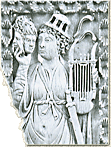
The dominant genre in Roman theatre was the mime drama. This was made up of
short, simple improvisatory scenes brilliantly portraying the daily round:
satirizing people, manners and actions; demythologizing episodes from myth
and debunking classical tragedy. Coarse witticisms and untrammelled grossness
were the staple of these mimes, their immediate aim being to get a mimicus
risus, a belly-laugh out of the audience.

The mime was both in prose (mimology) and in verse (mimody). The set was plain,
and the mime could perform anywhere s/he pleased, from the Forum to the
banqueting rooms of private houses. There were no chorus or characters,
and the actors usually played barefoot. This was the one theatrical genre in antiquity where women appeared on stage.
The mime, which started to flourish in the Hellenistic and Roman periods,
is thought to have originated in classical Sicily. It reached its peak with the
works of the famous Augustan mime writer, Philistion of Asia Minor, of whom it
was said that he quite literally laughed himself to death.

The pantomime developed from the mime. The whole play was performed by a single
player - a "quick-change" mime dancer. This was a single 'mute' actor - the
arch-mime - who, with rhythmic movements and gestures and the help of just one
mask with three or five faces, presented every one of the characters and episodes
in the play, down to animals, birds and the elements of Nature.
The Alexandrians Pylades and Bathyllus are thought to have introduced the danced
mime to Rome, the city which embraced it more than any other. But the cultural
trends of the Imperial Age favoured the ecumenical spread of the 'language of
movement', making the mime outstandingly popular throughout the Empire,
accessible as was it to the various peoples under Roman dominion,
crossing barriers of language and culture.
|